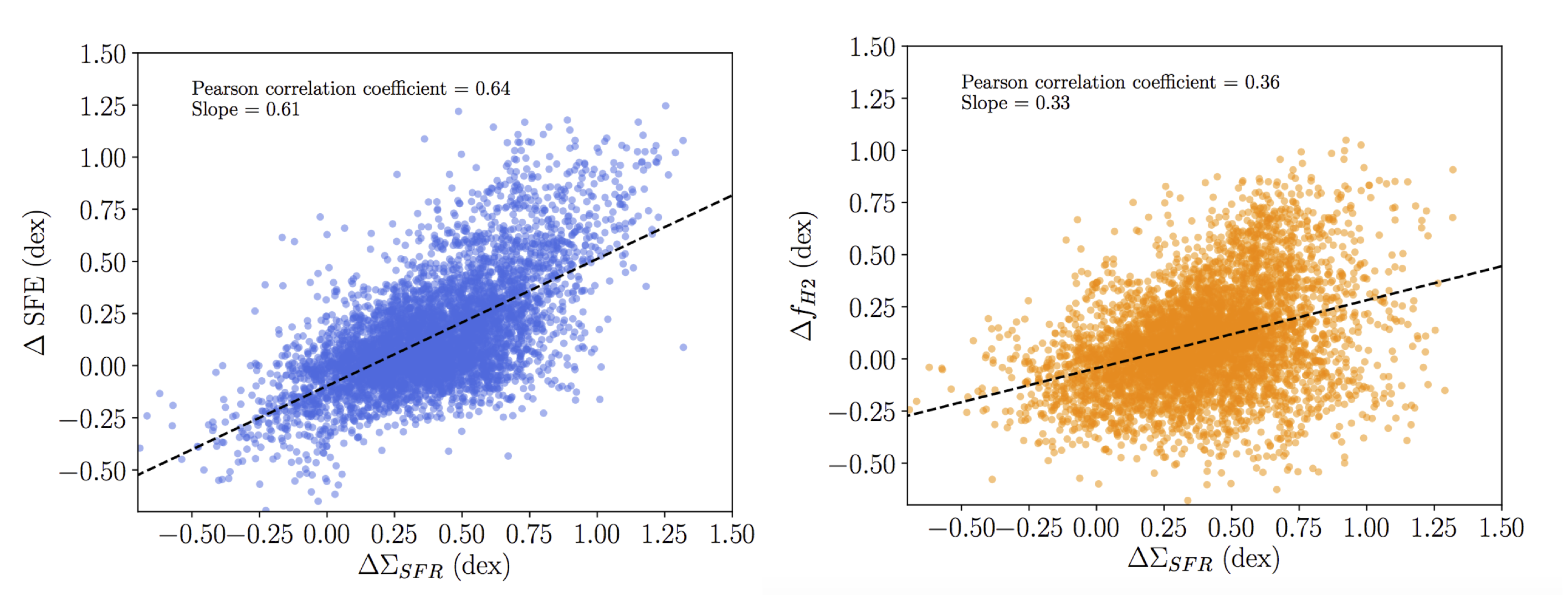Overall Goal: Star formation in galaxies is regulated by the amount of gas available to fuel the birth of new stars, and by feedback processes which alter the efficiency at which gas is converted into stars. By combining measurements of molecular gas from ALMA and star-formations rate from MaNGA, ALMaQUEST investigates how galaxies evolve to have enhanced star-formations or a halt in star-formation that leads to quiescence. ALMaQUEST is the first multiwavelength survey of its kind to target a broad range of specific star-formation rates, in order to capture the evolution from starburst to quenched galaxies.
What kpc-scale relations regulate star-formation?
Two broadly accepted scaling relations regulate the star-formation in a galaxy: the Kennicutt-Schimdt (KS) relation which links the star-formation rate in a particular region to the molecular gas abundance (Schmidt 1959; Kennicutt 1998), and the star-forming main sequence (SFMS, Brinchmann et al.2004) which identifies the correlation between star-formation rate surface density and stellar mass surface density. There is also a less well-studied correlation between the molecular gas surface density and the stellar mass surface density (Wong et al. 2013, Lin et al. 2019), more recently identified as the molecular gas main sequence. ALMaQUEST data has been used to investigate which relations are most “fundamental”, how they are interconnected, and how universal each relation is for different types of galaxies (Ellison et al. in prep).
We determine that the SFMS is the least “fundamental” of the three relations, given that it has the most scatter (Lin et al. 2019). We continue this investigation to determine that this scatter is primarily driven by changes in the star-formation efficiency (SFE), implying that the SFMS is highly dependent on the KS relation (Ellison et al. 2020).
What physical processes drive galaxy quenching?
By comparing the gas content to the star-formation in galaxies we can determine why some have suppressed star-formation (given what star-formation is expected from the global star-forming main sequence). The pilot study for ALMaQUEST (Lin et al. 2017) examined a small sample of green valley galaxies, revealing that most had a deficit of gas in the center, along with a reduced gas fraction and star-formation efficiency in the disc. The increased sample size will allow us to finalize the link between star-formation suppression and changes in the gas fraction and SFE (Lin et al. in prep), as well as characterizing these changes with radial profiles (Pan et al. in prep.).
Are starbursts driven by an enhanced gas fraction, or enhanced star-formation efficiency?
Starbursts are galaxies which have an elevated star-formation rate for their total stellar mass, i.e. they are outliers from the star-forming main sequence. By analyzing the offset from the resolved KS relation and the MGMS, we are able to determine that central starbursts are primarily driven by an enhanced SFE (an offset from the KS relation) (Ellison et al. 2020).

In particular, a portion of central starbursts are triggered by recent galaxy mergers. Using ALMaQUEST data we can examine whether merger-induced starbursts are also driven by SFE, or whether gas fraction plays a more important role (Thorp et al. in prep)
Future Projects
Cold-Molecular Gas-Metallicity Relation in ALMaQUEST
Many studies have discussed the relation between gas metallicity, stellar mass, and star-formation rate in local galaxies. ALMaQUEST provides the opportunity to investigate how this relation varies on local scales, and in particular how gas fraction and SFR shape those variations.
Balmer Decrement – Molecular Gas Mass Relation
The Balmer Decrement (BD=Hα/Hβ) traces the dust extinction in a galaxy, which can be use to infer the gas content in a galaxy (Concas & Popesso 2019). With ALMaQUEST we can investigate whether a local BD – molecular gas mass relation exists as well, allowing for approximations of the cold-gas reservoir in galaxies that only have optical observations.